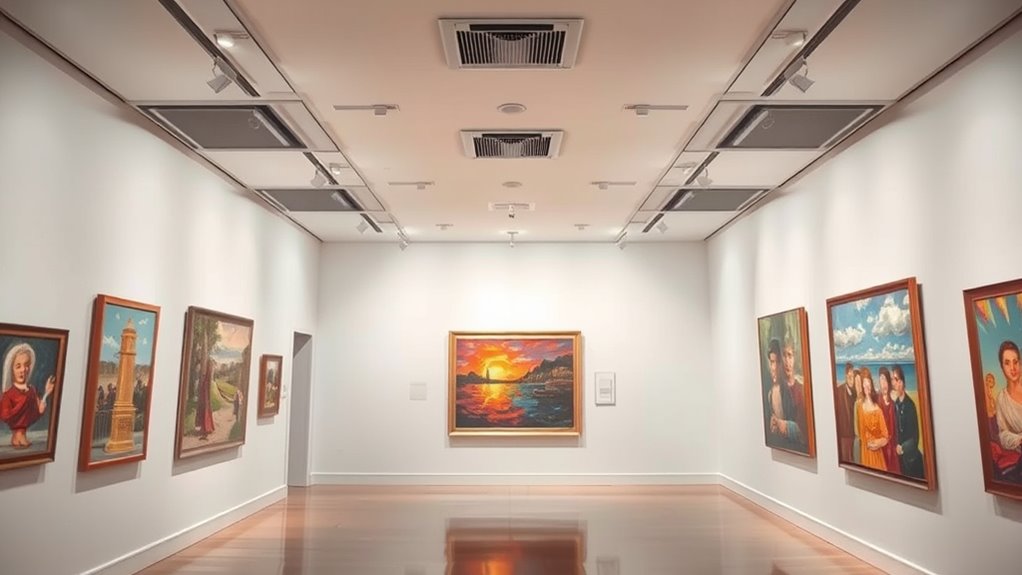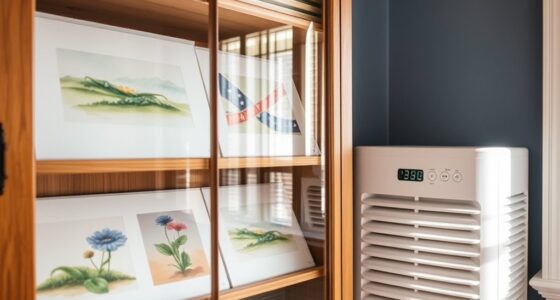Climate control protects artwork longevity by maintaining stable temperature and humidity levels, reducing stress on materials that can cause cracking, warping, or fading. It uses sensors, ventilation, and air purification to prevent environmental fluctuations and airborne pollutants from damaging pieces. Proper airflow and monitored conditions help prevent mold and deterioration. If you want to discover how these systems work together to preserve art, there’s more to explore below.
Key Takeaways
- Climate control maintains stable temperature and humidity levels, reducing material stress and preventing cracking, warping, and fading.
- Automated sensors and controls detect environmental fluctuations and make real-time adjustments to protect artworks.
- Proper ventilation and air purification eliminate pollutants, dust, and excess moisture that can cause deterioration.
- Consistent environmental conditions inhibit mold growth and chemical reactions that damage artworks over time.
- Advanced technologies like AI and nanomaterials offer tailored, minimally invasive preservation solutions, extending artwork longevity.
The Impact of Environmental Fluctuations on Artwork
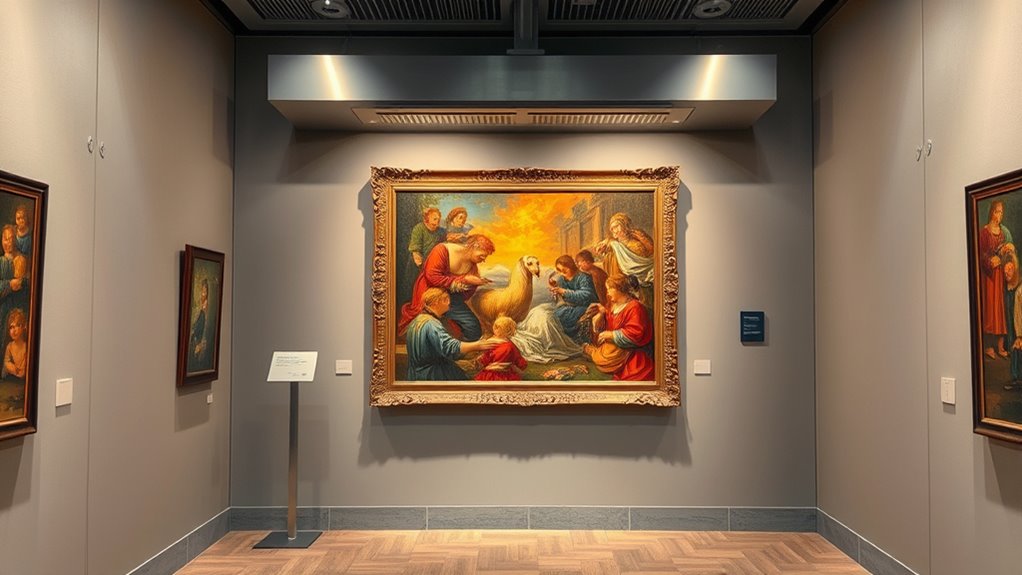
Environmental fluctuations, such as changes in temperature and humidity, can considerably damage artwork over time. These shifts can cause materials to expand and contract, leading to cracking, warping, or fading. Art movement influence plays a role in how sensitive certain artworks are; for example, delicate watercolor paintings or ancient manuscripts are particularly vulnerable. To combat this, artists and conservators have developed preservation techniques that mitigate damage from environmental changes. Proper storage, controlled lighting, and stable temperature and humidity levels help preserve the integrity of the artwork. By understanding how environmental fluctuations impact materials, you can implement strategies that protect your collection and maintain its value. Staying aware of these influences is essential for long-term preservation and respecting the artist’s original intent. Recognizing the importance of Gold IRA options can also serve as a valuable diversification method for safeguarding your assets against economic fluctuations.
Key Components of Climate Control Systems
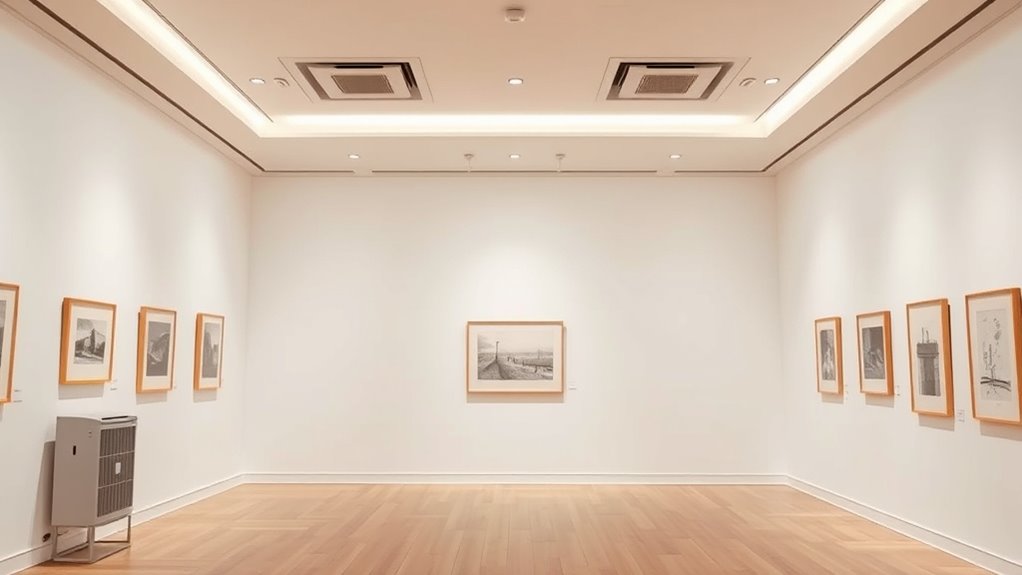
Effective climate control systems rely on several key components working together to maintain stable conditions. In artwork storage, climate sensors play a vital role by continuously monitoring temperature and humidity levels. These sensors detect any fluctuations that could harm your collection. The data they collect is sent to automated controls that adjust heating, cooling, and dehumidification systems as needed. Ventilation units also help circulate air evenly, preventing localized moisture buildup. Filtration systems ensure the air remains clean, reducing dust and pollutants that could damage artwork over time. Incorporating air purification technology can further enhance the environment by removing airborne contaminants. These components work seamlessly to create a controlled environment, protecting your artwork from environmental stressors. A well-designed climate control system ensures your collection remains stable, preserving its integrity for years to come.
Maintaining Optimal Temperature and Humidity Levels
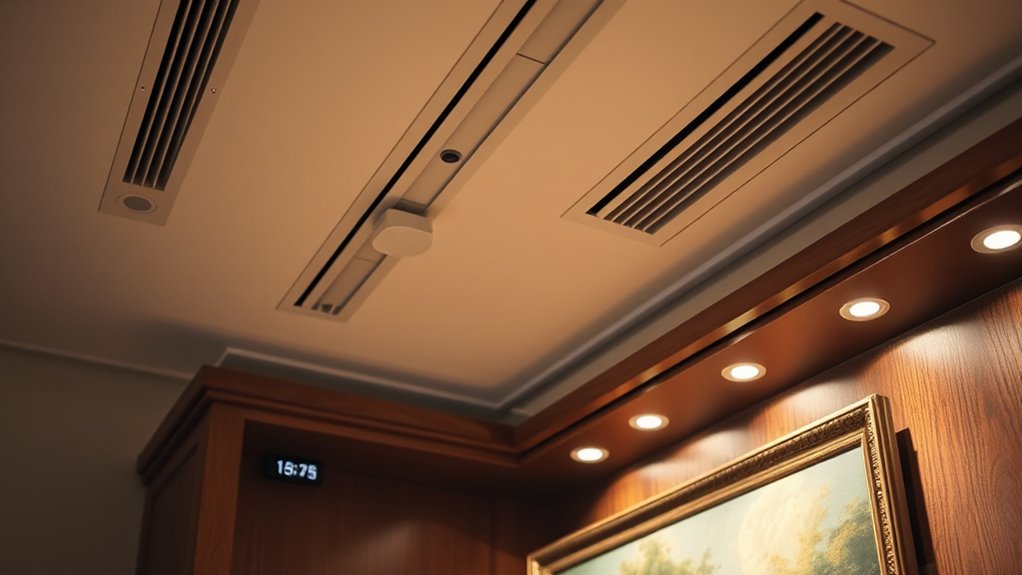
You need to keep temperature settings consistent to avoid stressing your artwork’s materials. Maintaining an ideal humidity range helps prevent warping, cracking, and mold growth. By controlling these factors, you protect your pieces from deterioration over time. Using appropriate self watering plant pots as an analogy, consistent moisture levels are essential for the long-term health of both plants and artwork.
Consistent Temperature Settings
Maintaining consistent temperature and humidity levels is essential for protecting artwork from deterioration. Fluctuations in artwork temperature can cause materials to expand and contract, leading to cracks, warping, or paint flaking. When climate consistency is disrupted, these stresses accelerate deterioration processes. To safeguard your collection, set your climate control system to a stable temperature, ideally between 65-75°F, depending on the artwork. Avoid sudden changes, as even brief temperature spikes can harm sensitive materials. Regularly monitor your environment with reliable gauges to ensure your climate remains steady. High refresh rates can also improve the accuracy of environmental monitoring devices, ensuring precise control. Consistent conditions minimize stress on the artwork, helping preserve its original appearance and structural integrity over time. By maintaining stable temperature settings, you create a protective environment that supports long-term artwork preservation.
Ideal Humidity Range
Keeping temperature stable is essential, but controlling humidity levels is equally important for artwork preservation. Maintaining the ideal humidity range guarantees climate stability, preventing materials from expanding, contracting, or cracking. Aim for artwork humidity levels between 40% and 50%, as fluctuations can cause damage over time. Think of a space where:
- The air feels comfortably cool and moist, not dry or damp.
- Paintings and sculptures remain steady, with no warping or peeling.
- The environment feels consistent, like a gentle breeze that never shifts.
Preventing Material Deterioration
Did you know that fluctuations in temperature and humidity can accelerate the deterioration of artwork? Maintaining stable conditions is vital for material stability and using effective conservation techniques. Sudden changes cause materials like paint, paper, and canvas to expand and contract, leading to cracks or warping. To prevent this, you should monitor and control environmental levels consistently. Proper environmental management ensures the longevity of artworks and preserves their original beauty. Here’s a quick guide:
| Temperature Range | Humidity Range | Effects of Fluctuations |
|---|---|---|
| 65-70°F | 45-55% | Material stability is preserved |
| Above 70°F | Above 55% | Accelerates deterioration |
| Below 65°F | Below 45% | Causes brittleness and cracking |
| Sudden shifts | Rapid swings | Damages artwork integrity |
| Consistent control | Steady environment | Prolongs artwork lifespan |
Effects of Proper Ventilation and Air Quality
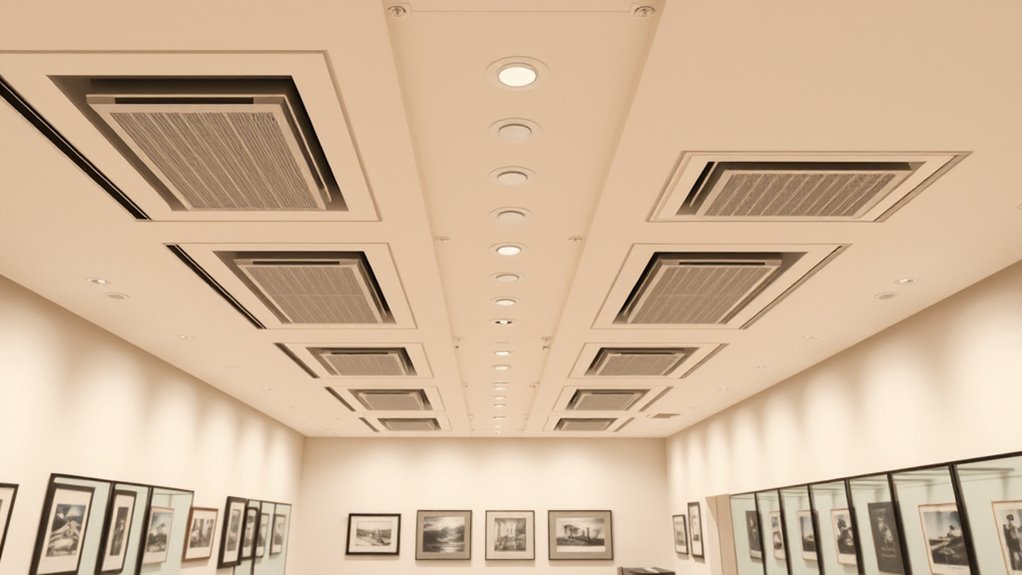
Proper ventilation and air quality play an essential role in preserving artwork, as inadequate airflow can lead to the buildup of harmful pollutants and excess humidity. Poor air circulation can cause dust, fumes, and moisture to settle on artwork, accelerating deterioration. When you maintain good airflow, you reduce these risks, ensuring your artwork display remains pristine. Additionally, proper ventilation improves visitor comfort, creating a fresh environment that encourages engagement without overwhelming senses. Imagine a gallery where the air feels crisp, and dust is barely noticeable. You’ll notice that the artwork remains vibrant longer, and visitors feel at ease exploring the space. Key elements include:
- Clear, dust-free display cases
- Controlled humidity levels
- Fresh, circulating air enhancing overall environment
- Incorporating natural lighting can also help reduce the reliance on artificial climate controls and positively impact the preservation environment.
Monitoring and Adjusting Climate Conditions
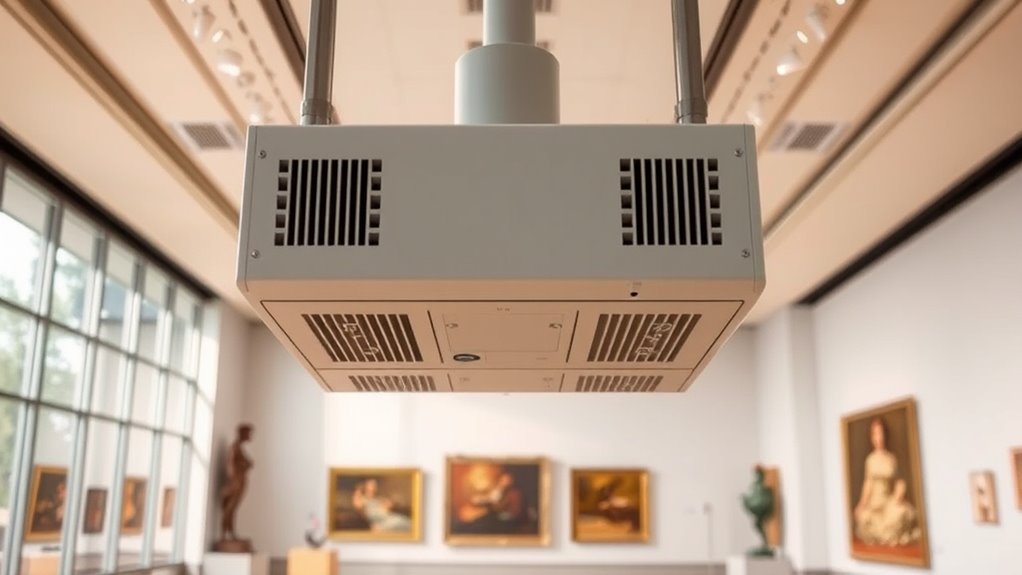
Effective monitoring and adjustment of climate conditions guarantee that your artwork remains in ideal preservation. Regular climate monitoring helps you detect fluctuations in temperature and humidity that could harm delicate materials. By continuously tracking these factors, you can quickly make adjustments to maintain stable conditions, preventing deterioration. Properly calibrated climate control systems support effective artwork restoration efforts by minimizing environmental stress. When you stay vigilant with climate monitoring, you reduce the risk of mold, warping, or fading caused by unsuitable environments. This proactive approach ensures your pieces stay protected over time, extending their lifespan. Additionally, using vetted climate control devices ensures reliability and accuracy in maintaining optimal conditions. Ultimately, consistent climate adjustments based on accurate data are essential for safeguarding your artwork’s integrity and ensuring its longevity for future generations.
Case Studies: Successful Preservation Through Climate Regulation

When climate regulation is meticulously implemented, it can substantially enhance the preservation of valuable artworks. In real-world cases, museums that prioritized climate adaptability saw remarkable results, ensuring art conservation over decades. For example, the Museum of Modern Art in New York maintained stable conditions, preventing fading and deterioration of sensitive pieces. Similarly, a historic European gallery used advanced climate control systems to safeguard priceless frescoes from humidity swings. These success stories highlight how precise climate management can extend artwork lifespan and maintain integrity. Visualize a gallery with:
- Consistent temperature and humidity levels
- Controlled airflow preventing mold
- Specialized systems adjusting to seasonal changes
- Efficient heat pump technology providing reliable climate regulation in various settings
These examples demonstrate how strategic climate regulation directly supports art conservation, protecting masterpieces for generations to come.
Future Innovations in Artwork Preservation Technology

Advancements in technology are poised to revolutionize how you protect and preserve artworks in the future. Artificial intelligence will enable real-time monitoring of environmental conditions and detect early signs of deterioration, allowing swift intervention. Material science innovations will lead to stronger, more durable conservation materials that better mimic original substrates, reducing damage over time. You’ll benefit from smart climate control systems that adapt dynamically to artwork needs, optimizing temperature and humidity with unprecedented precision. Additionally, new protective coatings and nanomaterials will shield artworks from pollutants and physical wear without compromising their appearance. These innovations will make preservation more effective, less invasive, and tailored to each piece’s unique requirements, ensuring artworks remain vibrant and intact for generations to come. Incorporating cybersecurity measures can also protect digital records associated with artwork provenance and condition monitoring, adding an extra layer of safeguarding.
Frequently Asked Questions
How Do Climate Control Systems Vary for Different Types of Artwork?
You need to understand that climate control systems vary based on artwork material and environmental sensitivity. For delicate pieces like textiles or paper, you’ll want strict control of humidity and temperature to prevent damage. For more resilient materials like metal or glass, the system can be less intense. Adjusting climate conditions helps preserve each artwork’s integrity, ensuring it remains in ideal condition regardless of the material or sensitivity level.
What Are Common Signs of Climate-Related Damage to Artwork?
You’ll notice signs of climate-related damage like cracks, warping, or discoloration in your artwork. Humidity fluctuations cause materials to expand and contract, leading to structural damage, while mold growth appears as fuzzy spots or staining. These issues often stem from inconsistent environmental conditions. To protect your artwork, maintain stable humidity levels and monitor for early mold signs, ensuring its preservation over time.
How Often Should Climate Conditions Be Checked in Art Preservation Spaces?
Think of your art preservation space as a delicate garden needing constant care. You should check climate conditions at least monthly, ensuring humidity fluctuations stay within recommended ranges and maintaining temperature stability. Regular monitoring helps catch issues before they cause damage, much like tending to a garden prevents weeds from taking over. Consistent checks keep your artwork safe, preserving its beauty for generations to come.
Can Climate Control Systems Prevent All Types of Artwork Deterioration?
Climate control systems can’t prevent all types of artwork deterioration, but they considerably reduce many risks. You should combine climate control with art restoration techniques and environmental monitoring tools to protect your collection. While these systems manage temperature and humidity, some damage from light, pollutants, or pests may still occur. Regular checks and proper preservation strategies help guarantee your artwork stays in the best condition possible over time.
What Is the Cost-Effectiveness of Implementing Advanced Climate Regulation?
Imagine planting a tree today that grows stronger over time—your investment pays off. The cost analysis of advanced climate regulation shows it’s a smart investment, protecting valuable artwork from deterioration. While initial expenses might seem high, the long-term benefits—preserving masterpieces and avoiding costly restorations—outweigh the costs. Implementing this technology guarantees your collection’s longevity, making it a cost-effective choice for safeguarding cultural treasures.
Conclusion
By controlling temperature, humidity, and air quality, you greatly extend your artwork’s lifespan. Did you know that improper climate conditions can accelerate artwork deterioration by up to 75%? Regular monitoring and adjustments ensure your pieces stay vibrant and intact for generations. Investing in a reliable climate control system isn’t just smart—it’s essential to protect your artistic treasures from the unseen threats of environmental fluctuations. Keep your collection safe with proactive preservation strategies.
